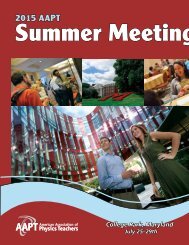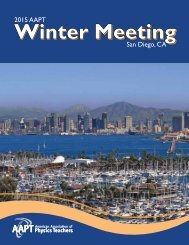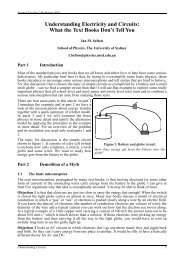Monday afternoonTOP02: Topical Discussion: TroubleshootingApparatusLocation: STSS 420BSponsor: Committee on ApparatusDate: Monday, July 28Time: 12–1:30 p.m.Presider: Luke DonforthIf you have lab equipment that doesn’t work or makes you believe in poltergeists,if you have a new use for old equipment that you want to share, orif you have stuff in storage you can’t even identify, bring pictures and we’llhave a roundtable discussion on keeping the objects of hands-on educationfunctional.TOP03: Topical Discussion: Physicsand SocietyLocation: Tate Lab 210Sponsor: Committee on Science Education for the PublicDate: Monday, July, 28’Time: 12–1:30 p.m.Presider: Brian JonesJoin your colleagues for an informal discussion about physics-relatedsocietal issues such as climate change, energy use, nuclear power, nuclearweapons, resource extraction, and pseudoscience. Share your ideas abouteffectively teaching these issues and communicating such information tothe general public, and hear what others are doing as well.TOP04: Topical Discussion: PER SoloFacultyLocation: STSS 432ASponsor: Committee on Research in Physics EducationCo-Sponsor: Committee on Professional ConcernsDate: Monday, July, 28Time: 12–1:30 p.m.Presider: Steve MaierAre you the only professional active in PER within your department? Arethere only one or two colleagues in close proximity you can talk “PERshop” with? The membership of Solo PER is larger than you may think, andmore diverse than most suspect. Join us for this crackerbarrel to connectwith other Solo PER professionals and learn what is being done to helpour/your endeavors. As in the past, bring questions, ideas, and professionalconcerns to share.TOP01: Topical Discussion: YouTubeShare-a-thonLocation: Tate Lab 210Sponsor: Committee on Physics in High SchoolsDate: Monday, July, 28Time: 1:30–3 p.m.Presider: Dean BairdShow us a favorite YouTube video for use in physics instruction. And tell ushow you use it. We’ll have a computer connected to the Internet, a projectorand speakers. You bring the video’s web address and, say, 50 copies ofcurriculum materials you use with the video (or a URL for the PDF). Thissession is always great fun in addition to being a treasure-trove of instructionalgems; laughter is guaranteed!Session BA: Panel – MOOCs and YouLocation: STSS 312Sponsor: Committee on Educational TechnologiesDate: Monday, July 28Time: 1:30–3:30 p.m.Presider: Saif RayyanWe’ll cut through the hype about MOOCs (Massive Open OnlineCourses) to present what physics teachers and education researchersmight want to know about them: What MOOCs are availablein physics? How are they different? What are the implications ofMOOCs on introductory physics offerings? How can you blendone with your on-campus course? Do people learn anything inthem, what insights offered for teaching on-campus courses, andwhat opportunities do they offer to the education research community?This panel will provide an overview of MOOCs, shortcontributions by people who’ve run Physics MOOCs, followed byquestions and discussion.BA01:1:30-3:30 p.m. From Online to Blended: Making theTransitionPanel – John W. Belcher, MIT, Massachusetts Ave., Cambridge, MA 02139;jbelcher@mit.eduSaif Rayan, Peter Dourmashkin, Lori Breslow, MITThe MIT Physics Department has offered two edX MOOCs based on ourintroductory physics courses in mechanics and electromagnetism. Thedepartment built these online offerings around the 35 recordings of ProfessorWalter Lewin’s lectures in each subject, complete and in sequence. Eachcourse had about 30,000 initial registrants, with about 2000 certificatesgranted. The structure of the online courses paralleled that of the residentialcourse. Based on our experience in building these courses online,we are now using the same platform in residential education at MIT toprovide resources to students, in a blended approach. The key to realizingthe potential of technology in education is the collaboration of experts inteaching and learning, educational researchers, computer scientists, anddisciplinary specialists, and we have assembled such a team to guide us inour residential use of the edX platform, as we will discuss.BA02: 1:30-3:30 p.m. Affordances of MOOCs and Humans:A Study Comparing in-person and MOOC Offering Instructionin Physics 1Panel – Noah D. Finkelstein, University of Colorado, Boulder, UCB 390- Dept.of Physics, Boulder, CO 80309; finkelsn@colorado.eduMichael Dubson, Katherine Goodman, Edmond Johnsen, Jack Olsen, Universityof Colorado BoulderDavid Lieberman, Queensborough CollegeWith all the attention to MOOCs, in fall 2013 we set out to explore thisspace, create and offer a MOOC, and to conduct a research study on howit was offered, how it was used, and the impacts on student learning andparticipation. Physics 1 for Physical Science Majors was simultaneouslyoffered through Coursera and to a live class. Through a variety of measures(of student learning, participation, demographics), we found a variety oftake-home messages from these various media. We find that this MOOC:supported participants in different ways (pedagogically, temporally, andgeographically), demonstrated that students can learn in these environments,addressed different audiences, tended to select for high- performing(well-prepared) students, limited potential forms interactivity, and causedsignificant consternation at the university administrative level. Many moredetails will be found in Dubson’s talk Wednesday afternoon. In this session,we seek to engage in a(n evidence-based) discussion, based on communityinterest [the YOU part] on: how to run, lessons learned, opportunities /concerns, politics, research studies needed and more.56
BA03: 1:30-3:30 p.m. A Physics MOOC That Helps Students,Researchers, and Teachers Learn*Panel – David E. Pritchard, MIT Room 26-241 / 77 Mass. Ave., Cambridge,MA 02139-4307; dpritch@mit.eduKimberly R. Colvin, John Champaign, Alwina Liu, Colin Fredericks, MITThe RELATE group (http://RELATE.MIT.edu) is now running its fourthMOOC, 8.MReV on edX.org. Pre-post testing showed normalized gain of0.31+/-0.02 independent of student initial skill or cohort with over 1000receiving certificates. This and other learning correlates differently withtime spent using various available resources. Our special track for teachershas forums on how to teach various topics, and for suggesting and vettingexternal resources. Our MOOC is a “user facility” for PER researchers whowish to run experiments using a control/experimental group protocol, orto vet assessment instruments. Currently nine researchers are collaboratingon seven projects: three are developing or testing instruments to measurevarious aspects of problem solving ability, three are developing new waysto understand and teach problem-solving expertise, and two involve usingmulti-dimensional psychometrics to discover whether actual student skillsdepend more on learning objective, cognitive category, question type, orquestion format. More collaborators are sought.*Work supported by NSF, MIT, and Google.Session BB: PER: Exploring ProblemSolving Approaches and SkillsLocation: STSS 220Sponsor: AAPTDate: Monday, July 28Time: 1:30–3:10 p.m.Presider: Andrew BoudreauxBB01: 1:30-1:40 p.m. Assessing Online Computer Coachesfor Problem Solving: Measures of UtilityContributed – Koblar A. Jackson, Central Michigan University, Department ofPhysics, Mt. Pleasant, MI 48858; jacks1ka@cmich.eduEvan Frodermann, Ken Heller, Leon Hsu, University of Minnesota-Twin CitiesAndrew Mason, University of Central ArkansasThe Physics Education Research Group at the University of Minnesota(UMN) is investigating the utility of a type of online computer coach topromote learning and aid in the development of problem-solving skillsin an introductory physics course. The first version of these coaches wasused in the first semester of large calculus-based introductory mechanicscourses at UMN. The utility of the coaches depends on their ease of useand their attractiveness to students as well as their efficacy. In this talk, wedescribe the techniques used to measure the utility of the coaches whenused as a part of the introductory course. This talk will also address thenatural use of the coaches by different segments of the student populationwithin the class. Q. Ryan, B. Aryal, and J-L. Lin also contributed tothis work. This project was partially supported by NSF DUE-0715615 andDUE-1226197.to the design of the second version of these coaches. A. Mason, B. Aryal,J-L. Lin, and K. A. Jackson also contributed to this talk. This work waspartially supported by NSF DUE-0715615 and DUE-1226197.BB03: 1:50-2 p.m. Influence of Visual Cueing and CorrectnessFeedback on Problem Solving*Contributed – Elise Agra, Kansas State University, Department of Physics,Manhattan, KS 66506; esgagra@gmail.comXian Wu, Mitchell Burkett, Lester C. Loschky, N. Sanjay Rebello, KansasState UniversityResearch has demonstrated that using visual cues can help to directstudents’ attention to relevant areas of a diagram and facilitate problemsolving. In this study, we investigate the effect of visual cues and correctnessfeedback in conceptual physics problems containing a diagram withrespect to the comprehension of physics concepts. Students enrolled in anintroductory mechanics course were individually interviewed. Using thinkaloudprotocol, students worked through four sets of problems containinga diagram. Each problem set contained an initial problem, six isomorphictraining problems, a near transfer problem, and a far transfer problem. Thestudents provided verbal responses to the problems. Students in the cuedcondition saw visual cues on the training problems, and students in thefeedback condition were told whether their responses were correct or incorrect.We discuss the influence of both cueing and feedback on students’ability to solve the training and transfer problems.*This material is based upon work supported by the National Science Foundationunder Grant Nos. 1138697 and 1348857.BB04: 2-2:10 p.m. Visual Cues Increase Efficiency in ExtractingRelevant Information from Diagrams*Contributed – Amy Rouinfar, Kansas State University, Department of Physics,Manhattan, KS 66506; amy.rouinfar@gmail.comElise Agra, Lester C. Loschky, N. Sanjay Rebello, Kansas State UniversityAdam M. Larson, University of FindlayVisual cues overlaid on diagrams and animations can help students attendto relevant features and facilitate problem solving. In this study we investigatedthe effects of visual cues on students’ eye movements as they solvedconceptual physics problems. Students (N=80) enrolled in an introductoryphysics course individually worked through four sets of problems, eachcontaining a diagram, while their eye movements were recorded and providedverbal responses. The problem sets contained an initial problem, sixisomorphic training problems, and a transfer problem. Those in the cuedcondition saw visual cues overlaid on the training problems. Each diagramcontained regions that were alternatively relevant to solving the problemcorrectly or related to common incorrect responses. The cued group moreaccurately answered the transfer problems (which did not have cues), andtheir eye movements showed they more efficiently extracted the necessaryinformation from the relevant area than the uncued group.*This material is based upon work supported by the National Science Foundationunder Grant No. 1138697.BB05: 2:10-2:20 p.m. The Effects of Problem-solving Trainingon Students’ Reasoning Abilities*Monday afternoonBB02: 1:40-1:50 p.m. Assessing Online Computer Coaches forProblem Solving: Educational ImpactContributed – Evan Frodermann, University of Minnesota-Twin Cities, 116Church St. SE, Minneapolis, MN 55455-0213; frodermann@physics.umn.eduJennifer Docktor, University of Wisconsin-La CrosseKen Heller, Leon Hsu, Qing Ryan, University of Colorado BoulderThe Physics Education Research Group at the University of Minnesota isdeveloping a set of online computer coaches to aid student learning in anintroductory physics course. This talk reports on the educational impactof implementing the first version of these coaches in the first semester ofseveral large calculus-based introductory mechanics courses. The talk willalso address how the results of this implementation are being used as inputContributed – Xian Wu, Kansas State University, Manhattan, KS 66506;xian@phys.ksu.eduElise Agra, Claudia Fracchiolla, N Sanjay Rebello, Kansas State UniversityWe study the effects of a computer-based training process on pre-serviceelementary teachers’ reasoning on introductory physics problems withdiagrams. The training process contains four problem sets that target commonlyknown naïve conceptions in physics. The problems include physicsdiagrams and text and require conceptual reasoning rather than computation.Each problem set has three training problems followed by solutions,one near transfer problem, and one far transfer problem. We have analyzedstudents’ verbal answers to elucidate the reasoning resources that they activatedto construct the different explanations that they gave in response tothe problems. We found that the students changed their reasoning dramaticallythrough the process as they were presented with solutions to trainingJuly 26–30, 2014 57
- Page 1:
AAPT SummerMeeting ProgramGuideMinn
- Page 5 and 6:
Welcome to MinneapolisThe 2014 Summ
- Page 7 and 8: Session FA: Remembering John Risley
- Page 10 and 11: Minneapolis -A city of lakes!Minnea
- Page 12 and 13: Meeting-at-a-GlanceMeeting-at-a-Gla
- Page 14 and 15: 3-4 p.m. Melba Phillips Toast : Mee
- Page 16: American Association ofPhysics Teac
- Page 20: 2014 Homer L. Dodge Citations for D
- Page 23 and 24: Plenary SpeakersThe Uncanny Physics
- Page 25 and 26: Free Commercial WorkshopsCW01: PASC
- Page 27 and 28: AAPT Exhibitor InformationAAPT Jour
- Page 29 and 30: TEL-Atomic, Inc.Booth #2041223 Gree
- Page 31 and 32: Session Rooms are in the STSS Build
- Page 33 and 34: Rashonda
- Page 35 and 36: W06: Inquiring into Radioactivity f
- Page 37 and 38: W20: Introductory Physics for Life
- Page 39 and 40: the generative and flexible use of
- Page 41 and 42: freely available online texts and i
- Page 45 and 46: Session SPS: SPS Undergraduate andG
- Page 47: SPS14:8-10 p.m. Electrochromic Devi
- Page 50 and 51: AA05: 9:10-9:20 a.m. Improving Seco
- Page 52 and 53: Monday morningAC02: 9:-9:30 a.m. Fr
- Page 54 and 55: Monday morninghoused in the College
- Page 56 and 57: Monday morningadd content to the te
- Page 60 and 61: Monday afternoonproblems and later
- Page 62 and 63: Monday afternoonnovation Hyperlab p
- Page 64 and 65: Session BF: Outreach: Fun Ways toEn
- Page 66 and 67: Monday afternoonBG04:2:40-2:50 p.m.
- Page 68 and 69: Monday afternoonto make the demonst
- Page 70 and 71: Monday afternoonwith students, on-
- Page 72 and 73: Monday afternoonCD03: 5-5:10 p.m. M
- Page 74 and 75: Monday afternoonCI01:Session CH: Pa
- Page 76 and 77: Are your students tap-happy for Fla
- Page 78 and 79: Monday afternoonPST1: Poster Sessio
- Page 80 and 81: Monday afternoonindicating and reco
- Page 82 and 83: Monday afternoonthat the optimal le
- Page 84 and 85: Monday afternoonthan males when the
- Page 86 and 87: Monday afternoonSaalih Allie, Unive
- Page 88 and 89: Monday afternooningful. We are a te
- Page 90 and 91: Monday afternoonPST1E06: 9:15-10 p.
- Page 92 and 93: (TAs): knowledge of introductory st
- Page 94 and 95: Tuesday morningToo often in the con
- Page 96 and 97: Tuesday morningexpose students to c
- Page 98 and 99: Tuesday morningCarolyn D. Sealfon,
- Page 100 and 101: Tuesday morningDG06:8:50-9 a.m. Exa
- Page 102 and 103: Tuesday morningSession DJ: Reform D
- Page 104 and 105: Tuesday afternoonSession EA: Panel
- Page 106 and 107: Tuesday afternoonEC03: 2-2:10 p.m.
- Page 108 and 109:
We focus on the design and study of
- Page 110 and 111:
EF04:2:10-2:20 p.m. Integration in
- Page 112 and 113:
Session EJ: TechnologiesLocation: S
- Page 114 and 115:
PST2: Poster Session 2Location: Cof
- Page 116 and 117:
Tuesday afternoonPoster - Marcos D.
- Page 118 and 119:
Tuesday afternoonevaluate the succe
- Page 120 and 121:
Tuesday afternoonIn Fall 2013, Geor
- Page 122 and 123:
Tuesday afternoonPST2C32: 5:45-6:30
- Page 124 and 125:
Tuesday afternoonthe direction of e
- Page 126 and 127:
Electrostatics Diagnostic (CUE), pr
- Page 128 and 129:
Wednesday morningFA03:8:30-10:30 a.
- Page 130 and 131:
FD03:8:50-9 a.m. Integrating Practi
- Page 132 and 133:
while they learn physics from two c
- Page 134 and 135:
homework, forum, at-home labs) and
- Page 136 and 137:
FK05:10-10:10 a.m. Women’s Ways o
- Page 138 and 139:
GA06:1:50-2 p.m. Do Individual Thin
- Page 140 and 141:
Bohr proposed that the electron orb
- Page 142 and 143:
Wednesday afternoon140(HPC) and CUD
- Page 144 and 145:
Wednesday afternoonof RBIS is not u
- Page 146 and 147:
Wednesday afternoon0. Sample cards
- Page 148 and 149:
Wednesday morningand fabrication. T
- Page 150 and 151:
Wednesday afternoonPST2G03: 1-1:45
- Page 152 and 153:
Wednesday afternoon150present preli
- Page 154 and 155:
Index of ParticipantsAbel, Yolanda,
- Page 156 and 157:
PST2C35Lincoln, James J., EE04, PST
- Page 158 and 159:
Campus MapU.M.156Portland
- Page 160 and 161:
Coffman Union - Dining-ChickFilA: 1
- Page 162 and 163:
#160
- Page 164:
San DiegoWe’ll see youin San Dieg
- Page 167 and 168:
NOTESJuly 26-30, 2014 165
- Page 169 and 170:
EDUCATIONwww.modusmed.comAn effecti






